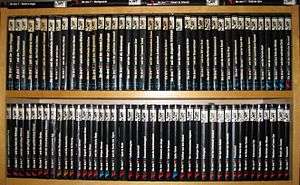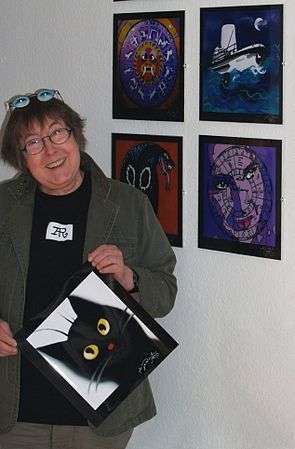Aiga Rasch
| Aiga Rasch | |
|---|---|
|
"Lapathia", 2008 | |
| Born |
9 July 1941 Stuttgart Germany |
| Died |
24 December 2009 Kirchheim unter Teck, Germany |
| Occupation |
Illustrator Graphic artist Painter |
| Spouse(s) |
1. Manfred Naegele 2. |
| Parent(s) |
Bodo Rasch (1903–1995) Lilo Rasch-Naegele (1914–1978) |
Aiga Rasch (9 July 1941 – 24 December 2009) was a German illustrator, graphic artist and painter.[1][2]
Life
Family provenance and childhood
Aiga Rasch was born in Stuttgart during the first part of the Second World War. Bodo Rasch (1903–1995), her father, was, like her younger brother, Mahmoud Bodo Rasch, an avant-garde architect.[3] Her mother, Lilo Rasch-Naegele (1914–1978), was an internationally established fashion photographer and illustrator,[4] and a member of the artists' group around Willi Baumeister.[5]
She turned to painting as a small child since, during the years of austerity that followed the end of the war, there were no toys available: instead, her mother gave her a brush and palette even when the tubes of paint were too hard for the child's fingers to control with any precision.[6] She grew up living in the family house her parents built after 1945 on the edge of the wild Schönbuch parkland to the south-west of the city, initially planning to become a writer. She enjoyed her education at the "Friedensschule" (literally: "Peace School") in Stuttgart, where school meals came from the kitchens of the American army, Stuttgart having ended up under US military control at the end of the war. She later recalled that the resulting school food was "healthier than it tasted" ("gesünder als sie schmeckt").[7] Shortly before taking her school leaving exams (Abitur) she entered a novel writing competition organised by the publishers, Kosmos Verlag. Her submission included her own illustrations. This gave her the opportunity to submit an embryonic "portfolio" to the publishing house, for which her mother already worked as a free-lance illustrator. For Aigo Rasch that novel writing competition marked the start of what later became a long and successful collaborative relationship with Kosmos.[8]
Career choices

After successfully negotiating her school leaving exams she transferred to Tübingen where her studies covered Germanistics, Philosophy and Psychology.[9] She was keen to avoid competing professionally with her mother,[7] and there was talk of a possible career as a journalist. During the summer vacation she volunteered for work with the works newspaper of the Ilseder Hütte (steelworks) where her talent as an illustrator was (re)discovered. In 1961 she abandoned her studies and embarked on the first of her two marriages.[10]
In 1962 she attended a preparatory course intended to lead to her acceptance as a student at the State Academy of Fine Arts in Stuttgart, but she very soon abandoned the idea. A teacher criticised her work because it was too similar to that produced by her mother: he recommended that she would progress better as a "self-taught" artist and she now followed this advice, with positive results.[4] She herself later observed that, at least when starting out, being the daughter of a famous artist was both a help and a hindrance.[6]
Career
In 1963 Rasch launched herself as a freelance graphic artist. Although she had no trouble passing the exams needed to gain membership of the State Academy of Fine Arts in Stuttgart, she had received no formal artistic training, a more striking paradox in Germany than in those countries where non-vocational degrees are relatively "normal". Instead of artistic training, she had her family tradition.[11] Her grandfather had specialised in producing paintings of flowers, and she had learned enough from her mother's professional career to be able to get a job. She joined the magazine "DM" and learned the business from the head of page layout. Between 1969 and 1980 she was a member of the West German Association of Professional Communication Designers ("Berufsverband der Deutschen Kommunikationsdesigner"/ BDG): during her last four years with the BDG she served as a member of its executive. On returning from a year abroad, in 1982 she became a member of the Stuttgart Württemberg Arts Association ("Württembergischer Kunstverein" and in 1986 she returned to the BDG, that year being elected chair of its Baden-Württemberg regional group. On the national level, between 1988 and 1990 she was an honorary BDG vice-president.[6]
Rasch took time abroad in 1980. She spent the year in Colorado, USA, learning Zen meditation with Gia-Fu Feng, Tai chi and a little Kung fu, all of which greatly changed her life and her way of working: she switched to water-colour technique and reduced the extent of her focus on designing book-covers. After 1992 the computer became her principal work tool.[7]
 The "three questions marks" logo
The "three questions marks" logo

Aiga Rasch became well known, above all, because of the title pages of the children's book series "Die drei ???" ("The three question marks": known for English-language readers as the "Three Investigators" series ). The first volumes were translated into German from American-English, and later achieved the cult status which in Germany they retain today partly because of the cover-pages. The designs are distinctive and unmistakable.
Rasch had worked for the publishers, Kosmos Verlag as a freelance contributor since 1962, providing illustrations for children's and young people's books. In 1969 she came across the first two volumes in the new series, "Das Gespensterschloss" ("The Secret of Terror Castle") and "Die flüsternde Mumie" ("The whispering Mummy") – based on Alfred Hitchcock films – with dust jackets by Jochen Bartsch, and she questioned their impact. She did not think they stood out particularly. She submitted alternative cover designs of her own, but these were met with initial suspicion. She then suggested to the publishers that if they used her proposal, and it failed to gain traction in the shops, she would forego her fee for the design.[9] The initial response remained negative, but eventually they were persuaded to let her provide a design for the cover page of the third volume in the series.
In 1970 she presented her cover page proposal for the third volume, "Flucht des Rubins", as a collage using just red, white and black. She later switched to a full-colour design, eventually switching to using the then new felt pens. The protagonists in the stories never featured in the title images, which was explained as an artistic device that would permit readers to develop their own mental images.[7]
Although the American series on which the German one was originally based originally ran to only 43 books, in Germany the "Die drei ???" series achieved a momentum which enabled Kosmos to produce 89 of the between 1970 and 1999, and they all came with covers designed by Aiga Rasch. Her contribution included 16 redesigned cover for new editions of previously published books. After she retired, Rasch worked again for Kosmos from 2006, producing more book cover designs, some now reworked digitally.
Rasch's cover designs were not restricted to books. After 1979 her "Three question marks" cover designs were also used for "Talking Books" issued under the Europa label. Including re-issues and talking books, publications featuring Aiga Rasch's cover designs have appeared on more than 30 million published copies in Germany alone. Her "Three question marks" cover-logo was also incorporated in designs used in China, Greece and Russia.
References
- ↑ Klaus Doderer; Sven Haarmann. "Aiga Rasch im Lexikon". Brigitta Dammann, i.A. rocky-beach.com. Retrieved 2 January 2017.
- ↑ "Trauer um Aiga Rasch". Malte Köhne i.A. hoerspielland. Retrieved 2 January 2017.
- ↑ Christoph Meurer (11 October 2016). "Koblenzer Museum widmet sich der Künstlerin der Drei Fragezeichen". Bonner Zeitungsdruckerei und Verlagsanstalt H. Neusser GmbH (General-Anzeiger). Retrieved 2 January 2017.
- 1 2 "Aiga Rasch Die Illustratorin der "drei ???" ... Ihre Titelbilder trugen dazu bei, dass "Die drei ???" Kultstatus erlangten. Heute wäre die Illustratorin Aiga Rasch 74 Jahre alt geworden. Google würdigt die Künstlerin mit einem Doodle.". Der Spiegel (online). 9 July 2015. Retrieved 2 January 2017.
- ↑ Rainer Vogt (13 December 2014). "Lilo Rasch-Naegele zum 100. ... Sie prägte das Bild der modernen Frau". Stuttgarter Nachrichten. Stuttgarter Nachrichten Verlagsgesellschaft mbH. Retrieved 2 January 2017.
- 1 2 3 Aiga Rasch. Mein Lebenslauf. Autobiographische Zusammenfassungen. u. a. verfasst für den Bund Deutscher Grafik-Designer zur Wahl der Vizepräsidentin, 20 July 1988.
- 1 2 3 4 "Wer ist Aiga Rasch?". Brigitta Dammann, i.A. rocky-beach.com. Retrieved 2 January 2017.
- ↑ "Die geheimen Bilder: Aiga Rasch und Die drei ???". Publicity for an exhibition held at Bietigheim-Bissingen at the end of 2014, featuring book-covers designed by Aiga Rasch. Städtische Galerie, Bietigheim-Bissingen. 22 November 2014. Retrieved 2 January 2017.
- 1 2 "Fünf Fakten zur Illustratorin der drei ???". Bild, Berlin. 9 July 2015. Retrieved 2 January 2017.
- ↑ "Aiga Rasch – Die drei ??? und die rätselhaften Bilder". Publicity for an exhibition held at Koblenz at the end of 2016 and the first weeks of 2017, featuring images by Aiga Rasch. Mittelrhein Museum Koblenz. October 2016. Retrieved 2 January 2017.
- ↑ Berufsanfang. Junge Grafik für Junge Leute. Deutscher Sparkassenverlag, Stuttgart 1977, p. 7.
